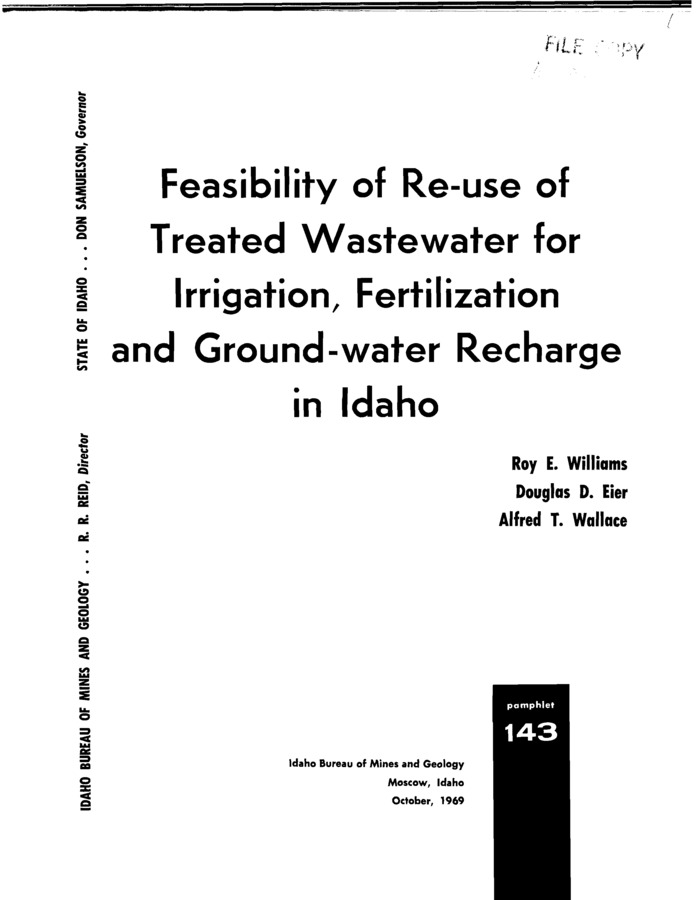PDF
Feasibility of re-use of treated wastewater for irrigation, fertilization and groundwater recharge in Idaho. Idaho Bureau of Mines and Geology, pamphlet 143 Item Info
- Title:
- Feasibility of re-use of treated wastewater for irrigation, fertilization and groundwater recharge in Idaho. Idaho Bureau of Mines and Geology, pamphlet 143
- Authors:
- Williams, Roy E.; Eier, Douglas D.; Wallace, Alfred T.
- Contributors:
- Idaho Water Resources Research Institute; IWRRI
- Date:
- 1969-10
- Description:
- The increasing rate of production of industrial and domestic wastewaters has prompted scientists and engineers to investigate methods of renovation which offer alternatives to disposal in surface water bodies. Reuse of effluent for irrigation, fertilization and groundwater recharge is among the techniques which have received much attention during the past several years. A large number of studies have demonstrated that vegetation and the proper geologic column are capable of greatly reducing the nutrient content of wastewater. Concomitantly the irrigated crop receives the normal benefit of the wastewater, a s well a s the benefit of the fertilizer contained therein. The fertilizer value (nitrogen, phosphorus and potassium) of domestic effluent has been estimated at about $18 per acre-foot; however, this figure can vary significantly. It has been demonstrated also that under appropriate hydrogeologic conditions wastewater renovated by a porous medium can be expected to meet U. S. Public Health Service drinking water standards. Appropriate hydrogeologic conditions include the presence of an unconsolidated porous medium (such as sand) through which the wastewater can move an appreciable distance (which will vary with geologic conditions) before entering a water supply; the absence of surficial, jointed rocks through which the wastewater might move without appreciable adsorption of dissolved solids by the porous medium; and a water table depth of at least five feet. Hydrogeologic conditions less than optimal will result in less than optimal renovation of the wastewater, in which case care must be taken during application if water supply sources are located near the disposal area. Only rarely will a given hydrogeologic environment not renovate wastewater to the equivalent of secondary (biological) treatment. In many cases renovation of wastewater by vegetation and the geologic column can be substituted for tertiary treatment.
- Subjects:
- industrial wastewater wastewater irrigation municipal wastewater
- Collection:
- Boise Basin
- Source:
- Idaho Water Resources Research Institute, University of Idaho
- Identifier:
- IWRRI Number 196924
- Publisher:
- Idaho Water Resources Research Institute, University of Idaho
- Contributing Institution:
- University of Idaho
- Type:
- Text
- Format:
- application/pdf
- Cataloger:
- wbv
- Date Digitized:
- 2012
- Language:
- eng
Source
- Preferred Citation:
- "Feasibility of re-use of treated wastewater for irrigation, fertilization and groundwater recharge in Idaho. Idaho Bureau of Mines and Geology, pamphlet 143", Idaho Waters Digital Library, University of Idaho Library Digital Collections, https://www.lib.uidaho.edu/digital/iwdl/items/iwdl-196924.html
Rights
- Rights:
- In copyright, educational use permitted. Educational use includes non-commercial reproduction of text and images in materials for teaching and research purposes. For other contexts beyond fair use, including digital reproduction, please contact the University of Idaho Library Special Collections and Archives Department at libspec@uidaho.edu. The University of Idaho Library is not liable for any violations of the law by users.
- Standardized Rights:
- http://rightsstatements.org/vocab/InC-EDU/1.0/

